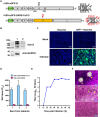Establishment of replication-competent vesicular stomatitis virus-based recombinant viruses suitable for SARS-CoV-2 entry and neutralization assays
- PMID: 32990161
- PMCID: PMC7594855
- DOI: 10.1080/22221751.2020.1830715
Establishment of replication-competent vesicular stomatitis virus-based recombinant viruses suitable for SARS-CoV-2 entry and neutralization assays
Abstract
Replication-competent vesicular stomatitis virus (VSV)-based recombinant viruses are useful tools for studying emerging and highly pathogenic enveloped viruses in level 2 biosafety facilities. Here, we used a replication-competent recombinant VSVs (rVSVs) encoding the spike (S) protein of SARS-CoV-2 in place of the original G glycoprotein (rVSV-eGFP-SARS-CoV-2) to develop a high-throughput entry assay for SARS-CoV-2. The S protein was incorporated into the recovered rVSV-eGFP-SARS-CoV-2 particles, which could be neutralized by sera from convalescent COVID-19 patients. The recombinant SARS-CoV-2 also displayed entry characteristics similar to the wild type virus, such as cell tropism and pH-dependence. The neutralizing titers of antibodies and sera measured by rVSV-eGFP-SARS-CoV-2 were highly correlated with those measured by wild-type viruses or pseudoviruses. Therefore, this is a safe and convenient screening tool for SARS-CoV-2, and it may promote the development of COVID-19 vaccines and therapeutics.
Keywords: SARS-CoV-2; VSV; entry; neutralization assay; replication-competent.
Conflict of interest statement
No potential conflict of interest was reported by the author(s).
Figures




Similar articles
-
A Replication-Competent Vesicular Stomatitis Virus for Studies of SARS-CoV-2 Spike-Mediated Cell Entry and Its Inhibition.Cell Host Microbe. 2020 Sep 9;28(3):486-496.e6. doi: 10.1016/j.chom.2020.06.020. Epub 2020 Jul 3. Cell Host Microbe. 2020. PMID: 32738193 Free PMC article.
-
Optimized Pseudotyping Conditions for the SARS-COV-2 Spike Glycoprotein.J Virol. 2020 Oct 14;94(21):e01062-20. doi: 10.1128/JVI.01062-20. Print 2020 Oct 14. J Virol. 2020. PMID: 32788194 Free PMC article.
-
Neutralizing Antibody and Soluble ACE2 Inhibition of a Replication-Competent VSV-SARS-CoV-2 and a Clinical Isolate of SARS-CoV-2.Cell Host Microbe. 2020 Sep 9;28(3):475-485.e5. doi: 10.1016/j.chom.2020.06.021. Epub 2020 Jul 3. Cell Host Microbe. 2020. PMID: 32735849 Free PMC article.
-
SARS-CoV-2 Evolutionary Adaptation toward Host Entry and Recognition of Receptor O-Acetyl Sialylation in Virus-Host Interaction.Int J Mol Sci. 2020 Jun 26;21(12):4549. doi: 10.3390/ijms21124549. Int J Mol Sci. 2020. PMID: 32604730 Free PMC article. Review.
-
Properties of Coronavirus and SARS-CoV-2.Malays J Pathol. 2020 Apr;42(1):3-11. Malays J Pathol. 2020. PMID: 32342926 Review.
Cited by
-
Vitamin C promotes ACE2 degradation and protects against SARS-CoV-2 infection.EMBO Rep. 2023 Apr 5;24(4):e56374. doi: 10.15252/embr.202256374. Epub 2023 Mar 6. EMBO Rep. 2023. PMID: 36876523 Free PMC article.
-
Neutralizing activity of Sputnik V vaccine sera against SARS-CoV-2 variants.Nat Commun. 2021 Jul 26;12(1):4598. doi: 10.1038/s41467-021-24909-9. Nat Commun. 2021. PMID: 34312390 Free PMC article.
-
Application of Pseudotyped Viruses.Adv Exp Med Biol. 2023;1407:45-60. doi: 10.1007/978-981-99-0113-5_3. Adv Exp Med Biol. 2023. PMID: 36920691 Review.
-
Growth, Antigenicity, and Immunogenicity of SARS-CoV-2 Spike Variants Revealed by a Live rVSV-SARS-CoV-2 Virus.Front Med (Lausanne). 2022 Jan 7;8:793437. doi: 10.3389/fmed.2021.793437. eCollection 2021. Front Med (Lausanne). 2022. PMID: 35071273 Free PMC article.
-
An antibody cocktail with broadened mutational resistance and effective protection against SARS-CoV-2.Sci China Life Sci. 2023 Jan;66(1):165-179. doi: 10.1007/s11427-022-2166-y. Epub 2022 Sep 29. Sci China Life Sci. 2023. PMID: 36184693 Free PMC article.
References
Publication types
MeSH terms
Substances
LinkOut - more resources
Full Text Sources
Other Literature Sources
Miscellaneous
